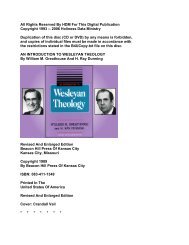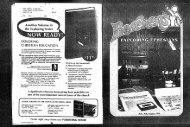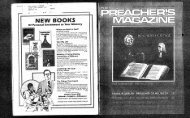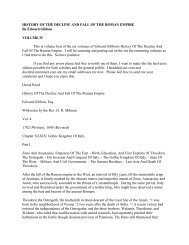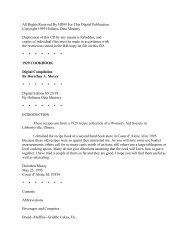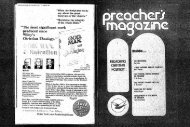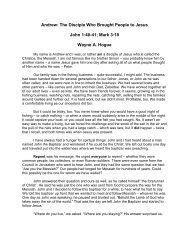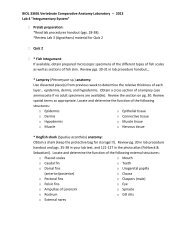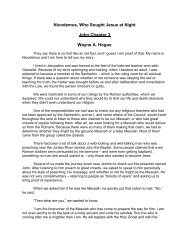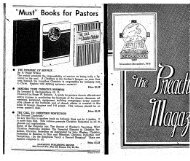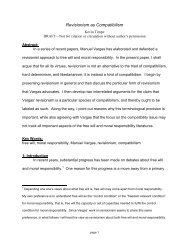Rights Reserved By HDM For This Digital - The Wesley Center Online
Rights Reserved By HDM For This Digital - The Wesley Center Online
Rights Reserved By HDM For This Digital - The Wesley Center Online
- No tags were found...
Create successful ePaper yourself
Turn your PDF publications into a flip-book with our unique Google optimized e-Paper software.
"What is your business, if I may ask? Maybe you're a saleswoman or something?"<br />
"Well, in a way, yes."<br />
Just about that time our host announced that dinner was ready. We gathered around the<br />
table. <strong>The</strong>re were about thirty of us. <strong>The</strong> rabbi, our host, went into the kitchen, got a bowl of water<br />
and girded himself with a towel. <strong>The</strong>n he came to each of us. First, he dipped his hands into the<br />
water and washed them. <strong>The</strong>n we dipped our hands into the water and washed them. He dried<br />
them. He took the place of a servant.<br />
How it reminded me of Another who did the same thing. <strong>The</strong> New Testament tells us that<br />
as He was washing Peter's feet, Peter said, "Lord not my feet only, but also my hands and my<br />
head." <strong>The</strong> Lord Jesus became a servant to us. <strong>The</strong> Son of God, a servant! How sweet this makes<br />
the communion! It also teaches that we must be clean before we come to the Lord's table. We must<br />
be clean before we can handle the elements. How many will have to answer at the judgment for<br />
eating unworthily!<br />
After he had washed our hands, the rabbi raised a plate on which were three squares of<br />
unleavened bread, called matzo. Each one was separated from the other by a white linen nap kin.<br />
As he raised this plate, he quoted from the twenty-second, twenty-third and twenty-fourth Psalms.<br />
In the twenty-second is the story of the crucifixion! In the twenty-third is the story of Christ's being<br />
in the grave and enduring death for us after having gone through the valley of suffering. <strong>The</strong><br />
twenty-fourth tells the story of His glorious, triumphant resurrection as the King of glory.<br />
After he had asked the blessing on the unleavened bread, the three matzos, he reached<br />
between the napkins and pulled out the little matzo. Not the top one, not the bottom one, but the<br />
middle one. Why the middle one?<br />
"Why not the top one, Rabbi?" I asked him. "Why not the bottom one? Why did you pull out<br />
the middle one?"<br />
He shrugged his shoulders. "We don't know. <strong>This</strong> is tradition, perhaps."<br />
"I know. It's tradition."<br />
I have asked many rabbis, many Jews. Nobody knows. It is a tradition that has been handed<br />
down, but it is certainly one that has been inspired of God because in it we can see the triune<br />
godhead. As the rabbi pulled out the middle matzo I could see that it beautifully pointed to the<br />
second Person of the triune God, the Lord Jesus Christ, whose body was broken for us. <strong>The</strong> rabbi<br />
then passed around a portion of this broken matzo for all to nibble on. Again, inspired of God, this<br />
ritual shows that all of us must partake of the broken body of Him in whom is no leaven at all. In<br />
the Bible leaven is spoken of as the hypocrisy of the Pharisees, as sin, that which ferments and<br />
causes spoilage in the literal sense. <strong>The</strong> rabbi took the other half of that which was broken and<br />
wrapped it in a white linen napkin.<br />
"Rabbi," I asked him again, "Why do you do this?"



